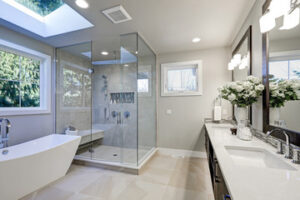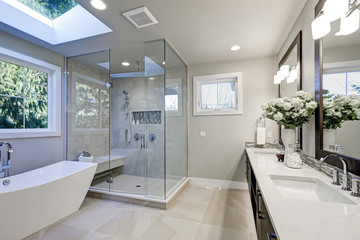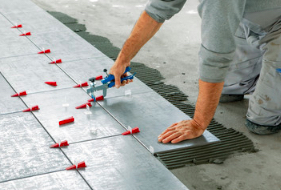Bathroom Remodeling Richmond VA can help you create a more functional layout and add luxury amenities. However, the cost of a bathroom remodel can quickly add up.
Many things can impact the overall costs of your renovation, including materials and labor. To reduce these costs, consider reusing or resurfacing fixtures and tiles in good condition.

Before starting any bathroom remodeling, it is important to set a budget. Many factors go into the overall cost of a remodel, and it is best to leave room for unexpected expenses. For example, if the bathtub is found to be leaking or the water heater is corroded during a remodel, this will increase the cost. A good rule of thumb is to include an extra 5-10% of the overall cost for contingencies.
The first step in setting a budget is to determine the scope of the project. This will help you decide whether or not to hire professionals. A professional remodeler can save you money in the long run by providing discounts on materials, preventing costly mistakes, and adding style and flair to your finished product.
Remodeling a bathroom can be as simple as installing new fixtures or painting the walls. These cosmetic changes are often less expensive than a full remodel and can add up to a significant increase in your home’s value. However, if you are planning to sell your home in the near future, it is often wiser to invest in a complete remodel to make sure that the results will appeal to potential buyers.
A full bathroom remodel is more extensive and can include expanding the space, removing or adding walls, changing the layout of the room, and bringing in new electrical and plumbing. These are more labor-intensive projects that require expertise and can be very costly. It is also recommended to hire a professional for these types of projects to avoid expensive mistakes and ensure that the work meets all local building codes.
To keep costs down, consider reusing fixtures that are still in good condition. Repainting or refinishing existing cabinets or bathtubs can cut costs considerably. Also, choosing off-the-shelf products instead of custom items will reduce costs significantly.
It is also a good idea to plan ahead and buy your materials well in advance. This will prevent delays and ensure that you get the best prices. You can do this by comparing prices at basic home improvement stores, specialty shops, and online markets.
A bathroom remodel is a major investment, and you want to make sure that it’s going to add value. It’s also important to find a design that fits your aesthetic preferences and lifestyle. For this reason, it’s a good idea to work with a professional designer to ensure that your renovation is successful.
A lot of things can affect the cost of a bathroom remodel, including its scope and complexity. It’s worth spending some time on the planning phase, because it will help you determine what features are essential and which ones can wait. For example, if you’re remodeling an older home, it may be more cost-effective to leave some of the existing elements in place rather than spend extra money replacing them.
It’s important to consider your bathroom’s lighting when planning a remodel. Poor lighting can render the space impractical or even dangerous. A well-lit bathroom should have layers of task, accent, and ambient lighting. A well-lit room will also look bigger and more inviting.
Another consideration when planning a bathroom remodel is storage. It’s important to plan ahead for all the things you need to store in your bathroom, including towels, washcloths, and cleaning supplies. You can make more efficient use of your storage space by reorganizing the layout or adding new cabinets or drawers.
While a complete redesign is often the goal of a bathroom remodel, it’s also possible to keep your costs down by replacing only certain elements. For instance, if your walls have several coats of concrete and wire lath, it’s often cheaper to leave them in place than to remove them. This will save you a lot of time and money, as well as reduce the amount of labor required to complete the project.
If you’re not a fan of white, a colorful paint scheme can liven up your bathroom. You can also add bright accessories like bath towels, rugs, and art to enhance the space.
Another great addition to any bathroom is a sound system. A sound system will give you the option to listen to your favorite music while you’re taking a shower or bath. You can even pair your sound system with a TV to create the ultimate relaxing space. If you have a windowless bathroom, you can add plants to the space for added beauty and to filter out toxins. Plants such as lucky bamboo, ferns, and philodendrons thrive in the high humidity levels of bathrooms.
Choosing the right materials is one of the most important decisions you will make during your bathroom remodel. You want to choose stylish materials that enhance the design of your bathroom, as well as functional ones that are easy to use and clean. You will also need to consider the budget and durability of each material. Once you have decided on a style and budget, it is time to start acquiring your bathroom remodeling materials.
When it comes to materials, there are many options available for a bathroom remodel, including ceramic tile and stone. These are durable and come in a variety of styles, shapes, and colors to match any design aesthetic. They are also resistant to moisture, making them a good choice for high-traffic areas. You may also want to consider using wood flooring in your bathroom. Wood provides a warm and natural look, and it is easy to clean. It is also water-resistant, which will protect against mold and mildew.
Other materials that can be used for a bathroom remodel include quartz and solid surface countertops. These are durable and scratch-resistant, which makes them a good choice for high-traffic bathrooms. They also have a high return on investment, adding to the value of your home. Other cost-effective bathroom materials include composite and laminate cabinets, vinyl flooring, and linoleum.
In addition to being cost-effective, bathroom renovations can help homeowners save money on utility bills by upgrading fixtures and appliances to more efficient models. For example, replacing old drain plumbing with newer PVC pipe can reduce the risk of clogs and lower water bills by reducing wasteful sewage flow.
Another way to save on utilities is to upgrade the lighting in your bathroom. This will not only increase the aesthetic of your bathroom, but it will also save on electricity costs by decreasing your usage. Replacing traditional light bulbs with LED lights will also cut down on energy costs and reduce your environmental impact.
Lastly, you should consider increasing storage space in your bathroom to minimize clutter. This will improve the functionality of your bathroom and reduce the risk of health issues from dust and debris that can accumulate in small spaces.
A top-notch bathroom remodeling contractor can make a huge difference in the overall quality of the project. This is why homeowners should carefully research and interview contractors before making a hiring decision. A well-chosen pro can help the homeowner avoid costly mistakes that can derail the entire project.
Contractors who specialize in bathroom renovations can provide expertise on efficient layouts and specialized fixture solutions. They can also help the homeowner select materials that are both functional and attractive.
Homeowners should consider a number of factors when choosing a contractor, including previous projects and customer reviews. It is also important to find out if the contractor offers a warranty for their work. This can give the homeowner peace of mind in case something goes wrong after the project is completed.
When interviewing potential bathroom remodelers, homeowners should ask for examples of their work. They should look for photos that show a similar design aesthetic to the homeowner’s desired results. Homeowners should also ask whether the contractor has experience with any complicated engineering elements that might be part of the renovation, such as moving walls or rerouting plumbing and electrical lines.
It’s also a good idea to talk to friends and neighbors who have recently had their bathrooms remodeled. This can provide a firsthand account of the contractor’s capabilities and customer service skills. Homeowners can also find out if the contractor has any issues with communication and scheduling that might impact their ability to complete the work on time.
Depending on the size of the remodel and scope, the contractor may need to subcontract certain parts of the work. This is especially true for large, complex projects. When in doubt, the homeowner should ask the contractor for a list of subcontractors and their license numbers. Homeowners should also check that the subcontractors are insured.
The best contractors will have a solid background in construction and a portfolio of past work to show off. In addition, they will have a strong understanding of plumbing and electrical systems, as well as general remodeling techniques. They should also have knowledge of ADA compliance, which is important for completing projects that include grab bars and other mobility aids.


